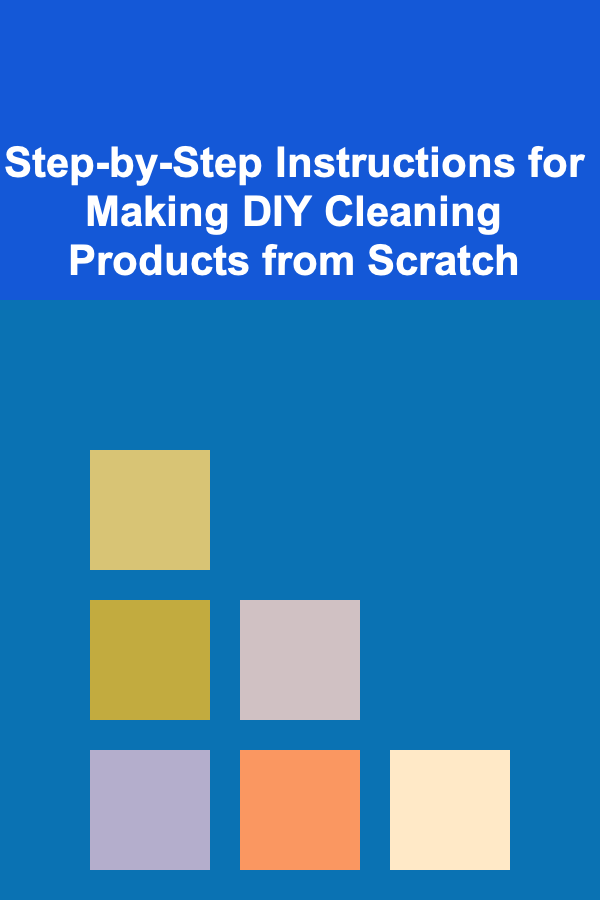
Step-by-Step Instructions for Making DIY Cleaning Products from Scratch
ebook include PDF & Audio bundle (Micro Guide)
$12.99$10.99
Limited Time Offer! Order within the next:

In today's world, more and more people are looking for ways to reduce their environmental impact, save money, and create healthier home environments. One of the best ways to achieve these goals is by making your own cleaning products from scratch. DIY cleaning products are not only effective and eco-friendly but can also be customized to meet your specific needs. In this guide, we will walk you through the process of creating your own cleaning products from scratch, using simple, natural ingredients that are both safe and efficient.
Why Make Your Own Cleaning Products?
Before diving into the steps, let's first explore why you should consider making your own cleaning products:
- Healthier for You and Your Family: Many commercial cleaning products contain harsh chemicals that can cause health problems, especially for young children, pets, and people with sensitive skin or allergies. DIY cleaning products typically use natural ingredients like vinegar, baking soda, and essential oils, which are safer alternatives.
- Cost-Effective: Purchasing commercial cleaning products regularly can quickly add up. DIY cleaning products are usually made from inexpensive ingredients, and you can make a large quantity for a fraction of the price of store-bought options.
- Environmentally Friendly: Homemade cleaners are typically free from the plastic packaging and toxic chemicals that contribute to pollution. By using biodegradable ingredients, you're reducing your carbon footprint and helping protect the environment.
- Customizable Scents and Strength: When you make your own cleaning products, you have control over the scent and cleaning power. You can choose essential oils that you love, or adjust the formula to create a cleaner that works best for your needs.
Basic Ingredients for DIY Cleaning Products
Before you start, you'll need to gather some essential ingredients. Here are the common components used in DIY cleaning products:
- Vinegar: Known for its disinfecting and deodorizing properties, vinegar is a natural powerhouse for cleaning. It's great for removing stains, soap scum, and even mildew.
- Baking Soda: This is an excellent abrasive cleaner that can help scrub surfaces without scratching. It's also great for deodorizing.
- Castile Soap: A plant-based soap that's gentle on surfaces but effective at breaking down grease and grime.
- Essential Oils: These oils not only provide a pleasant scent but also offer various antibacterial, antiviral, and antifungal properties. Popular choices include tea tree, lavender, lemon, and eucalyptus.
- Water: Often used as a base for diluting and mixing ingredients.
- Rubbing Alcohol: Alcohol can help disinfect surfaces and also acts as a solvent.
- Hydrogen Peroxide: Another natural disinfectant that works well on stains and mildew.
- Citrus Peels: The natural oils found in citrus peels are powerful for cutting through grease and leaving a fresh scent.
Step-by-Step Guide for Making DIY Cleaning Products
1. All-Purpose Cleaner
An all-purpose cleaner is one of the most versatile DIY cleaning products. It can be used for countertops, sinks, and other surfaces in your kitchen and bathroom.
Ingredients:
- 1 cup of water
- 1 cup of white vinegar
- 1 tablespoon of baking soda
- 10-15 drops of essential oil (e.g., lemon, lavender, or tea tree oil)
Instructions:
- In a large mixing bowl, combine the water and vinegar.
- Add the baking soda slowly, stirring constantly to avoid fizzing.
- Once the baking soda is fully dissolved, add the essential oil and stir.
- Pour the mixture into a spray bottle and shake well before use.
- Spray on surfaces and wipe clean with a cloth or sponge.
Tip: If you prefer a stronger cleaning solution, you can increase the vinegar ratio, or use rubbing alcohol for added disinfectant power.
2. Glass Cleaner
This glass cleaner is streak-free and works wonders on windows, mirrors, and glass tables.
Ingredients:
- 1 cup of water
- 1 cup of white vinegar
- 1 tablespoon of cornstarch
Instructions:
- In a spray bottle, mix water and vinegar.
- Add the cornstarch and shake the bottle to dissolve the powder.
- Spray directly on glass surfaces and wipe clean with a microfiber cloth.
Tip: For a smudge-free finish, use a clean, dry microfiber cloth to buff the glass.
3. Natural Scrubbing Cleaner
If you're dealing with tough stains, especially on kitchen surfaces like sinks, stovetops, or bathtubs, this scrubbing cleaner will do the job.
Ingredients:
- 1/2 cup of baking soda
- 1/4 cup of liquid Castile soap
- 1 tablespoon of white vinegar
- 10 drops of essential oil (optional)
Instructions:
- In a small bowl, mix the baking soda and Castile soap to form a thick paste.
- Add vinegar slowly and mix until the paste reaches your desired consistency.
- Add a few drops of essential oil for fragrance if desired.
- Apply the paste to the affected surface, scrub with a sponge or brush, and rinse.
Tip: This cleaner can be used on a variety of surfaces, but be cautious on delicate surfaces like granite or marble, as abrasives may cause scratches.
4. Disinfecting Spray
For areas that require extra germ-fighting power, such as bathrooms or high-touch areas (like doorknobs and light switches), this disinfecting spray is perfect.
Ingredients:
- 1 cup of water
- 1/2 cup of rubbing alcohol
- 1/4 cup of hydrogen peroxide
- 10-15 drops of tea tree oil (for added disinfectant power)
Instructions:
- Mix the water, rubbing alcohol, and hydrogen peroxide in a spray bottle.
- Add tea tree oil for its antimicrobial properties and shake well.
- Spray onto surfaces and let it sit for a few minutes before wiping it clean with a cloth.
Tip: Always store hydrogen peroxide in a dark container, as sunlight can break down its effectiveness.
5. Floor Cleaner
Making your own floor cleaner ensures that you're using non-toxic ingredients on the floors your children and pets play on.
Ingredients:
- 1 gallon of hot water
- 1/4 cup of Castile soap
- 1/4 cup of white vinegar
- 10-15 drops of essential oil (e.g., eucalyptus or lemon)
Instructions:
- Fill a bucket with hot water and add Castile soap.
- Add vinegar and stir.
- Drop in your essential oil and mix again.
- Mop your floors with the solution, making sure to wring out the mop before use.
Tip: This solution works well on most hard floors (wood, tile, vinyl). For wood floors, ensure the mixture is not too soapy to prevent residue buildup.
6. Fabric Softener
If you're tired of using store-bought fabric softeners with synthetic fragrances and chemicals, this DIY version is a natural alternative that works wonders.
Ingredients:
- 2 cups of white vinegar
- 10-15 drops of essential oil (optional)
- 1 tablespoon of baking soda
Instructions:
- In a mixing bowl, combine the vinegar and baking soda. Stir until the baking soda is dissolved.
- Add the essential oils for a fresh scent, if desired.
- Pour the mixture into your washing machine's fabric softener compartment.
Tip: The vinegar helps soften fabrics, and the baking soda neutralizes odors. This natural fabric softener can also help prevent lint buildup in your dryer.
Tips for Storing and Using DIY Cleaning Products
- Label Your Cleaners: When making multiple products, be sure to label your bottles with the contents and instructions for use. This will make it easier to find what you need and ensure safety.
- Test Before Full Use: Some natural ingredients, like essential oils, can be strong. Always test the cleaner on a small, inconspicuous area before using it on larger surfaces.
- Storage: Store your DIY cleaning products in dark glass bottles when possible, as light can degrade certain ingredients, like essential oils and hydrogen peroxide.
- Stay Safe: Even though DIY cleaners use natural ingredients, always keep them out of reach of children and pets, and avoid mixing certain substances (e.g., vinegar and bleach) that can create harmful fumes.
Conclusion
Making your own cleaning products from scratch is an empowering and rewarding process. It allows you to customize the cleaning experience to your preferences while ensuring that the products you use are safe for your family, effective, and environmentally friendly. By following the simple steps outlined in this guide, you'll be well on your way to a cleaner, healthier home with less reliance on harmful chemicals and excessive packaging.
Reading More From Our Other Websites
- [Home Party Planning 101] How to Plan a Home Party: What Are the Best Tips for a Seamless Event?
- [Home Maintenance 101] How to Maintain Your Home's Garage Floor
- [Organization Tip 101] How to Repurpose Old Furniture for Kid Room Storage
- [Personal Care Tips 101] How to Use Makeup Primer to Create a Smooth Base for Powder Products
- [Home Cleaning 101] How to Clean and Maintain Your Ceiling Fans and Light Fixtures
- [Organization Tip 101] How to Design a Toy Closet that Works for You
- [Home Pet Care 101] How to Set Up an Indoor Pet Enrichment Station
- [Personal Investment 101] How to Analyze a Company's Financial Report: A Step-by-Step Guide for Beginners
- [Rock Climbing Tip 101] Fun Climbing Games and Activities to Keep Kids Engaged on the Wall
- [Scrapbooking Tip 101] DIY Design Ideas: Customizing Your Scrapbooking Paper Pads for Personalized Layouts

How to Sell Your Deep Learning Models for Passive Income
Read More
How To Promote Independent Play and Learning
Read More
10 Tips for Displaying Art Prints in a Gallery Wall
Read More
10 Tips for Designing a Landscape for Wildlife
Read More
Stage Management for Outdoor Performances: A Practical Guide
Read More
How to Transition from Project Manager to Product Owner
Read MoreOther Products

How to Sell Your Deep Learning Models for Passive Income
Read More
How To Promote Independent Play and Learning
Read More
10 Tips for Displaying Art Prints in a Gallery Wall
Read More
10 Tips for Designing a Landscape for Wildlife
Read More
Stage Management for Outdoor Performances: A Practical Guide
Read More